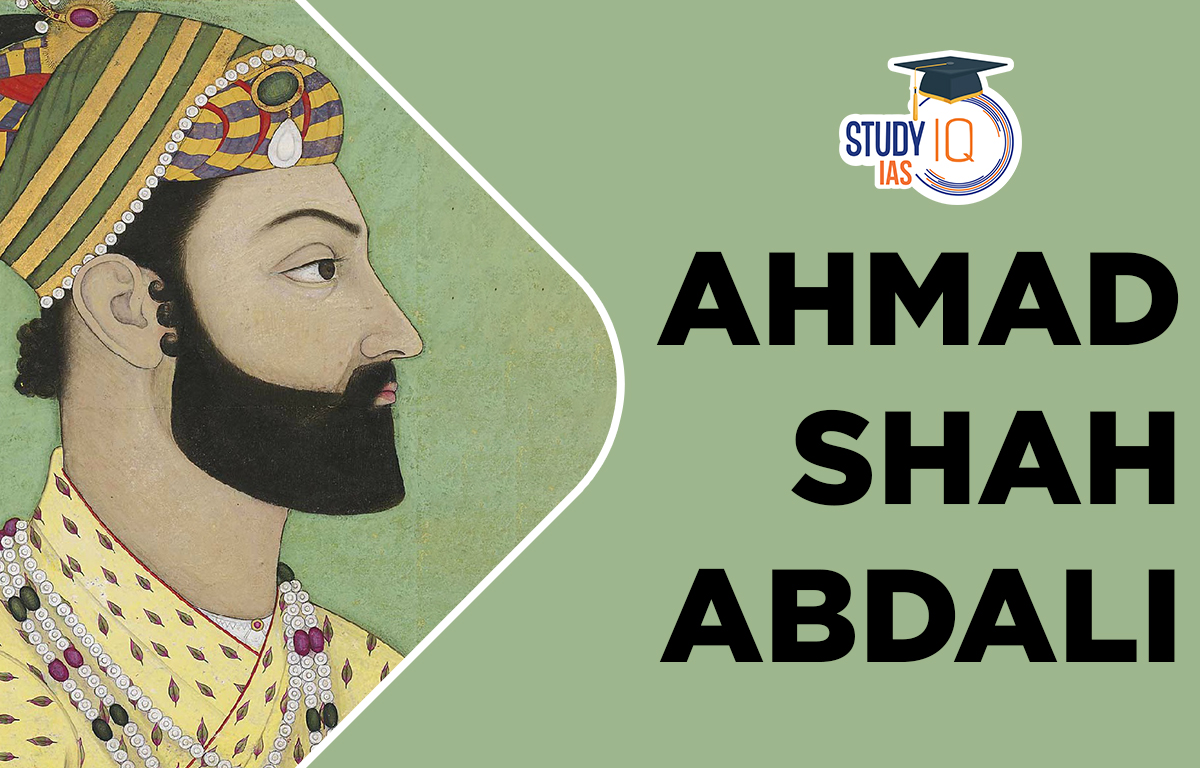Table of Contents
Ahmad Shah Abdali
Ahmad Shah Abdali, also known as Ahmad Shah Durrani or Ahmad Khan Abdali, was the founder of the Durrani Empire and the contemporary state of Afghanistan. Ahmad Shah Abdali (or Ahmad Shah Durrani), who was chosen to succeed Nadir Shah after the latter’s death in 1747, repeatedly attacked India between 1748 and 1767. Students will learn about Ahmed Shah Abdali in this post, and it will be useful while students study for the UPSC Civil Service Exam.
Ahmed Shah Abdali Early Life and Family
Mohammad Zaman Khan, the ruler of Herat and head of the Abdali clan, gave birth to Abdali in Multan (then part of the Mughal Empire, now Pakistan) in 1722. Sadozais were Durrani’s ancestors, while Alakozai was his mother. In June 1729, the Zulfiqar-led Abdali army submitted to the newly installed Persian king Nader Shah Afshar. However, they quickly staged a coup and seized control of Mashhad and Herat.
In July 1730, he overcame Ibrahim Khan, a military commander and Nader Shah’s sibling. Nadir Shah had been enlisting the Abdalis into his army since around 1729. After the capture of Kandahar in 1738, Durrani and his brother Zulfiqar were freed and granted important positions in Nader Shah’s administration.
Zulfiqar was named Mazandaran’s governor, and Durrani remained Nader Shah’s personal attendant. In Nader Shah’s service, Durrani distinguished himself by leading the Abdali Regiment, a cavalry of 4,000 soldiers and commanders, after ascending from the position of personal attendant (yaswal). The Abdali Regiment was a member of Nader Shah’s army when he invaded the Mughal Empire in 1738.
Ahmed Shah Abdali and Durani Empire
Ahmad Shah Abdali founded and developed the Durrani Kingdom, also known as the Sadozai Kingdom and the Afghan Empire, which spanned Central Asia, the Middle East, and South Asia. At its height, the empire ruled over parts of eastern Turkmenistan, northern India, northeastern and southeastern Iran, modern-day Afghanistan, and Pakistan.
Second only to the Ottoman Empire in terms of strength during the second half of the eighteenth century was the Durrani Empire. With the assistance of his Baloch allies, Ahmad Shah Abdali united the several Pashtun tribes and created the Durrani Empire, which at its height included Kashmir, modern-day Afghanistan, Pakistan, parts of northeastern Iran, and eastern Turkmenistan.
The Durranis were superseded by the Barakzai dynasty in the first half of the nineteenth century. After the Hotak dynasty, Ahmad Shah and his descendants were the second Pashtun rulers of Kandahar, derived from the Durrani Popalzai line (formerly known as the Abdalis). Due in large part to Ahmad Shah Durrani’s leadership, the Durranis gained notoriety in the latter half of the 18th century.
Ahmed Shah Abdali Invasion in India
Between 1748 and 1767, Ahmad Shah Durrani invaded India eight times.. After Nadir Shah’s death, Ahmad Shah Durrani rose to the Afghan throne and started plundering the wealth of the surrounding lands. When Abdali encountered the Sikhs on the banks of the Chenab while travelling to India, he eventually retreated after ambushing numerous individuals in the Chota Ghalughara and Vada Ghalughara.
The Sikhs rose up after Durrani left for Afghanistan and took control of several towns in the Punjab region. His numerous attacks destroyed the Mughal Empire and dealt a severe blow to northern Maratha aspirations at Panipat, leaving a power vacuum. The frequency of his repeated invasions was a reflection of his “tireless energy, ambition, and purpose.”
Afghanistan was unable to provide food for its citizens or financial support for the government because it was a poor and “backward” nation. In order to plunder and exploit India’s resources, Abdali believed it was “necessary” to attack this “rich but poorly guarded neighbouring nation.” He also wanted to establish “political hegemony” in India.
He was “ready to jump into the decadent Mughal power” to fill the “political vacuum without any waste of time” as the Mughal empire was disintegrating under his rule. Abdali took control of Delhi in 1757 and appointed an Afghan caretaker to watch over the Mughal Emperor. Before leaving, Abdali had acknowledged Najib-ud-Daula, the ruler of Rohilla, as the empire’s Mir Bakhshi and Alamgir II as the Mughal emperor. Najib-ud-Daula was to serve as Abdali’s personal supreme agent.
Najib-ud-Daula was driven out of Delhi in 1758 by Raghunath Rao, a Maratha chieftain who also took control of Punjab. In 1759, Ahmad Shah Abdali came back to India to seek revenge on the Marathas. Abdali defeated the Marathas at the Third Battle of Panipat, which took place in 1761. Abdali’s last invasion took place in 1767.
Ahmed Shah Abdali UPSC
Afghan tribal chief of the Durrani clan, Ahamad Shah Abdali, also went by the name Ahamad Shah Durrani. He took the Afghan throne in 1747 after Nadir Shah was assassinated. He was in charge from 1747 until his death in 1773. He invaded India eight times during this time, seized Punjab, and won the Third Battle of Panipat in 1761 against the Marathas. This page contains all the information you need to know about Ahmed Shah Abdali for the UPSC exam.


 Story of Meera Bai and Her Devotion For ...
Story of Meera Bai and Her Devotion For ...
 Desert Climate, Distribution, Climatic C...
Desert Climate, Distribution, Climatic C...
 Deserts of India Map, Features of Thar D...
Deserts of India Map, Features of Thar D...





















